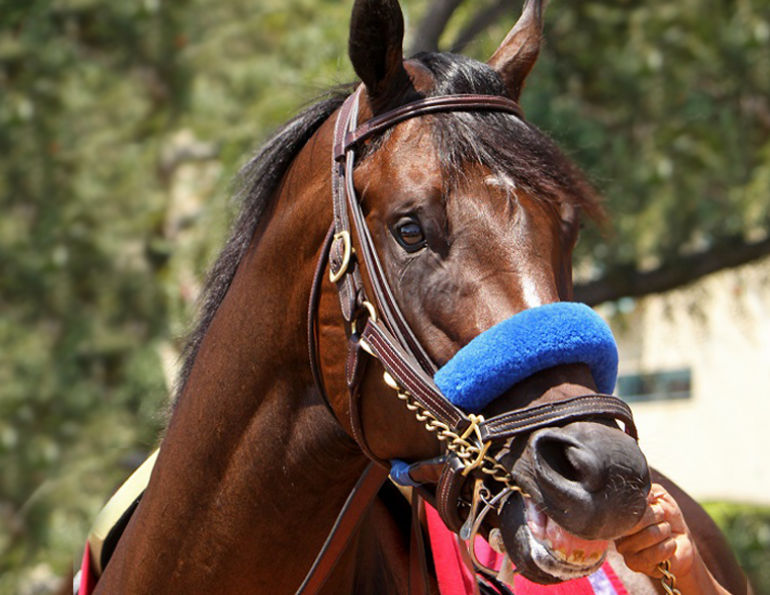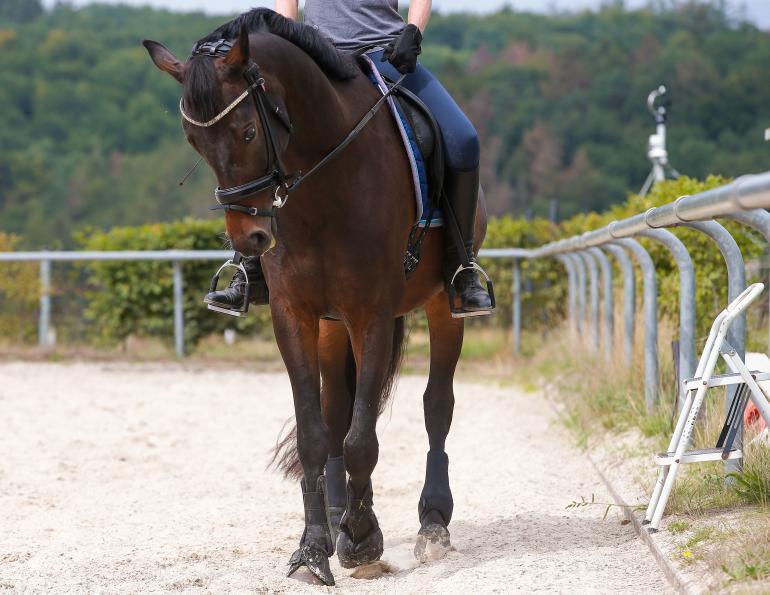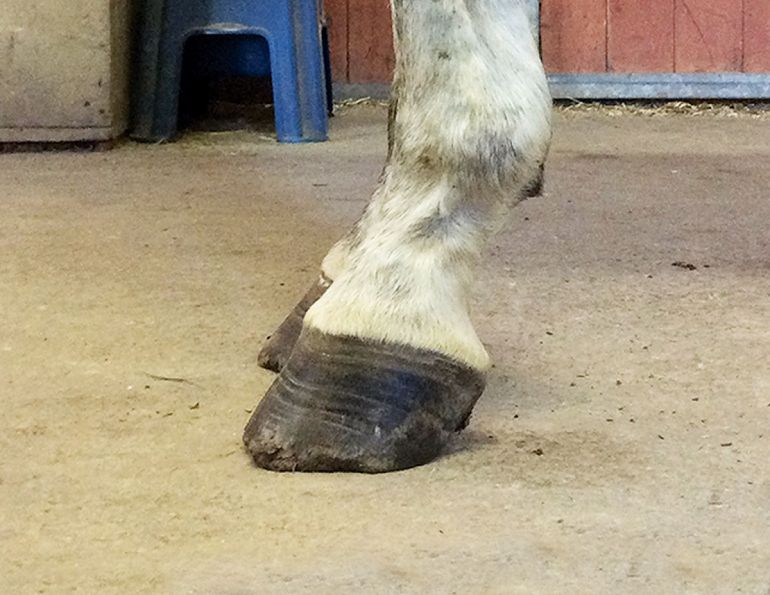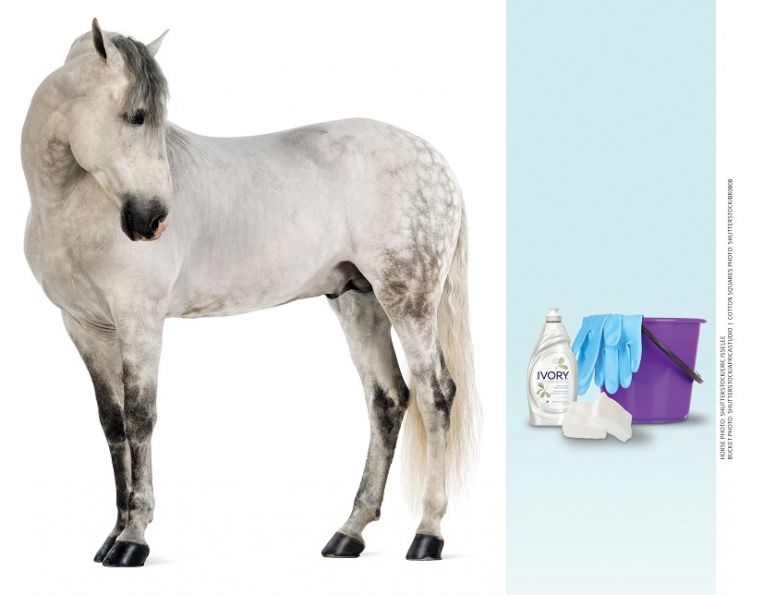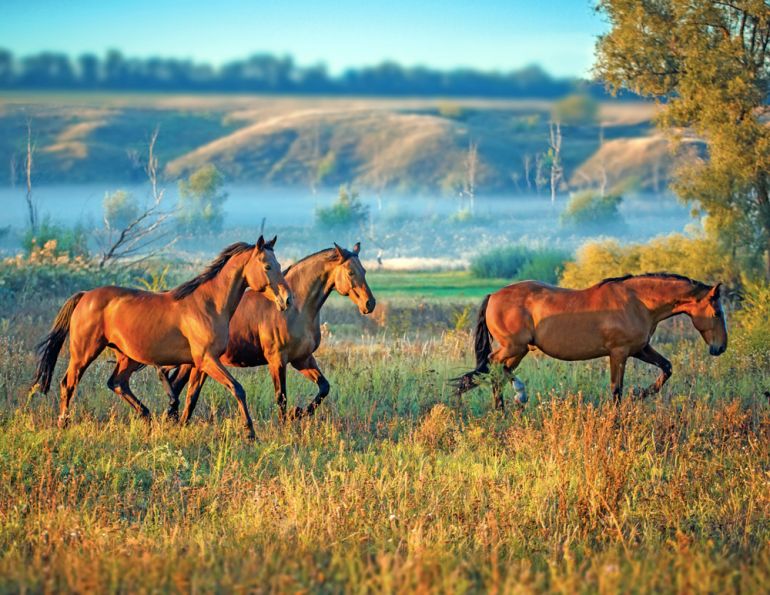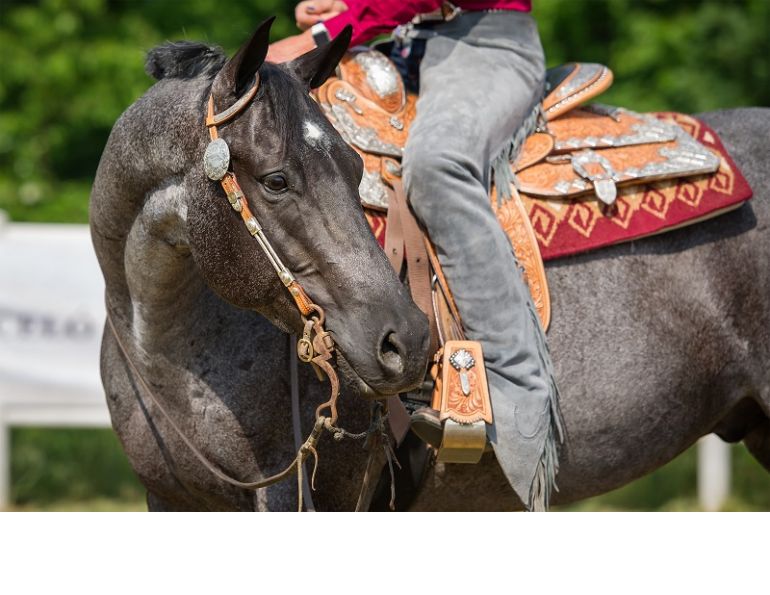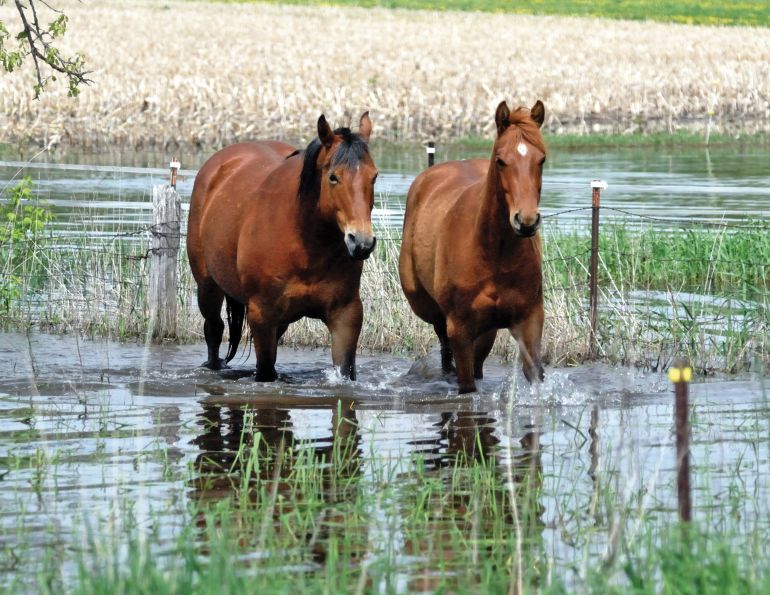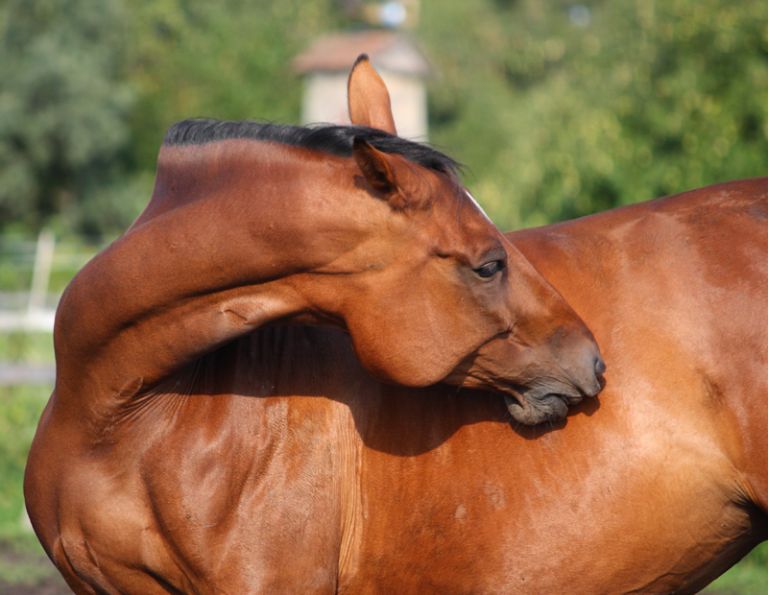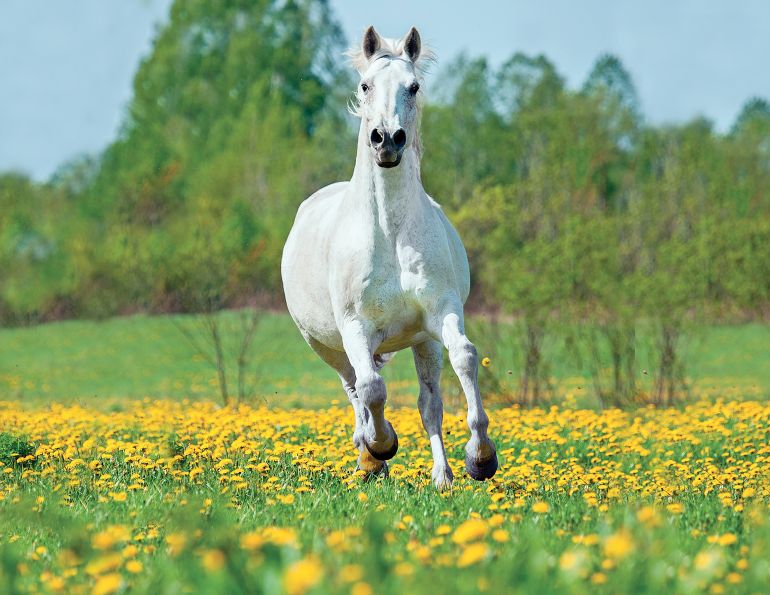…With a Little Help From Your Farrier
By Ben Yager, CJF
The horse is a companion, a worker, an athlete, a pet. This noble beast has been our ally and partner since first domesticated some 6,000 years ago. They deserve the best possible care and respect for their faithful toil and service.
Today the horse continues to serve us in a variety of roles. The job description may be that of a pasture companion, a trail riding partner, or a school horse. He might pull a sightseeing carriage, skid logs in the bush, push cattle on a ranch, or compete as a top international athlete. But one overarching issue that remains controversial across all areas of the horse industry is hoof care. And without the help of a qualified farrier, hooves and the physical structure of the horse are going to suffer.
Is your farrier certified with the American Farrier’s Association (AFA)? Did he or she serve an extensive apprenticeship at the beginning of their career? Does your farrier pursue additional education? It takes approximately four to five years of extensive studies and training to become a competent farrier who is useful and helpful in solving hoof-related issues – rather than causing them. And this is just the platform from which their career should launch; the learning and education should never stop.
In Canada, there are no minimum requirements or licensing to regulate a person who practices farriery. This is why the American Farrier’s Association has played such an important role in the education of students graduating from farrier schools here in Canada. The AHA also offers continual education to already-established farriers through certification clinics and contests.
Unlike other countries such as England, where you must serve a strict apprenticeship complete with classes, internship, and exams, here in Canada it’s left completely up to the individual farrier to self-educate. Some circumstances allow farriers to be placed in an apprenticeship situation for four years after they graduate school. They can go on to do their AFA exams to attain their Certified Journeyman Farrier (CJF) status after completing their apprenticeship.
Although there are many other farrier examination processes in North America and abroad, the AFA Journeyman exams remain the standard that all farriers should ideally attain in North America.
Not many farriers will take on apprentices. Not many farriers are certified or qualified to educate an apprentice. We therefore have a vicious cycle of isolation and under-educated persons practicing farriery in this country. This results in some horse owners believing that more harm than good is being done, and that all shoeing is detrimental to horses.
The basic shoeing job by many farriers is a flat shoe, fit hot or cold, nailed on the foot. In preparing the foot to receive a shoe, the foot should be properly trimmed, flare-dressed, and balanced to accept the appropriately fitted shoe. Properly positioned nails of adequate number and size should be used to attach the shoe to the foot. Shoes can also have clips; a well-fitted clip is the equivalent of two nails in the hoof.
Flare dressing is the act of removing excess growth and hoof wall distortion caused by inequality of weight-bearing upon the hoof capsule.
Related: Finding the Hoof Care Balance - Top Tips & Myth Busters
Flare dressing should mimic the natural intended shape of the hoof (baring any gross pathology that may require different trimming techniques), and follow the hairline (coronet band), and the white line (the guideline for placing horseshoe nails to be driven into the hoof). These elements must correlate to create a strong hoof capsule. Shoe shape is also based on these elements; therefore, flare dressing and shoe shape go hand in hand (Figure 1).
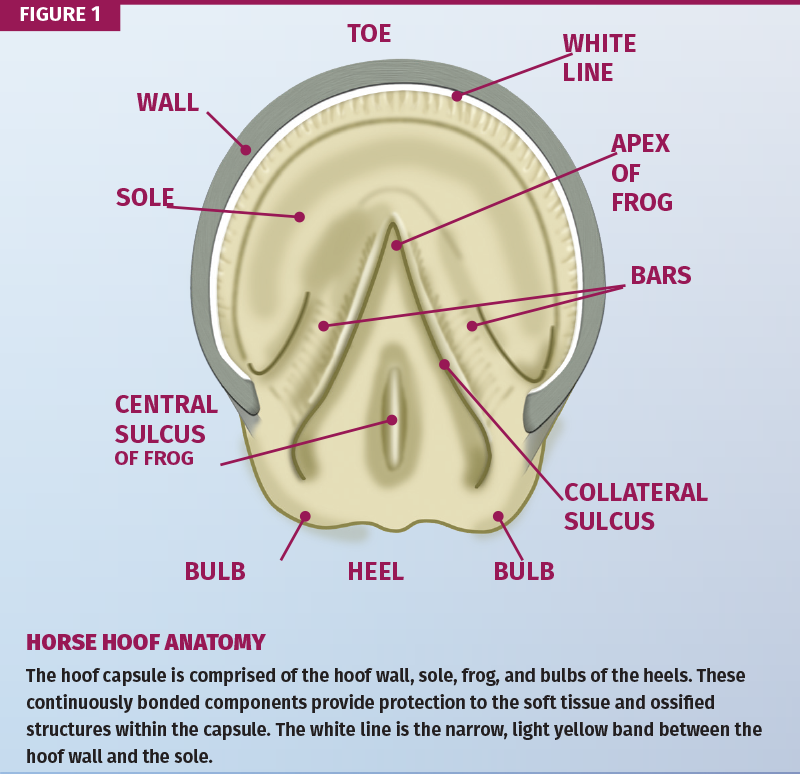
When choosing trimming techniques, it is important to remember that horses have been removed from their natural habitat. What we do with the horny (the harder exterior hoof structures) greatly influences the sensitive structures within the hoof capsule. Proper trimming is the foundation for all good shoeing jobs.
Flare dressing and trimming should be taken very seriously. Catering to the hoof-pastern alignment (HPA) is a fine art. The HPA is comprised of the long pastern bone (P1 or first phalanx), the short pastern bone (P2 or second phalanx), and the coffin bone (P3 or third phalanx) (Figure 2).
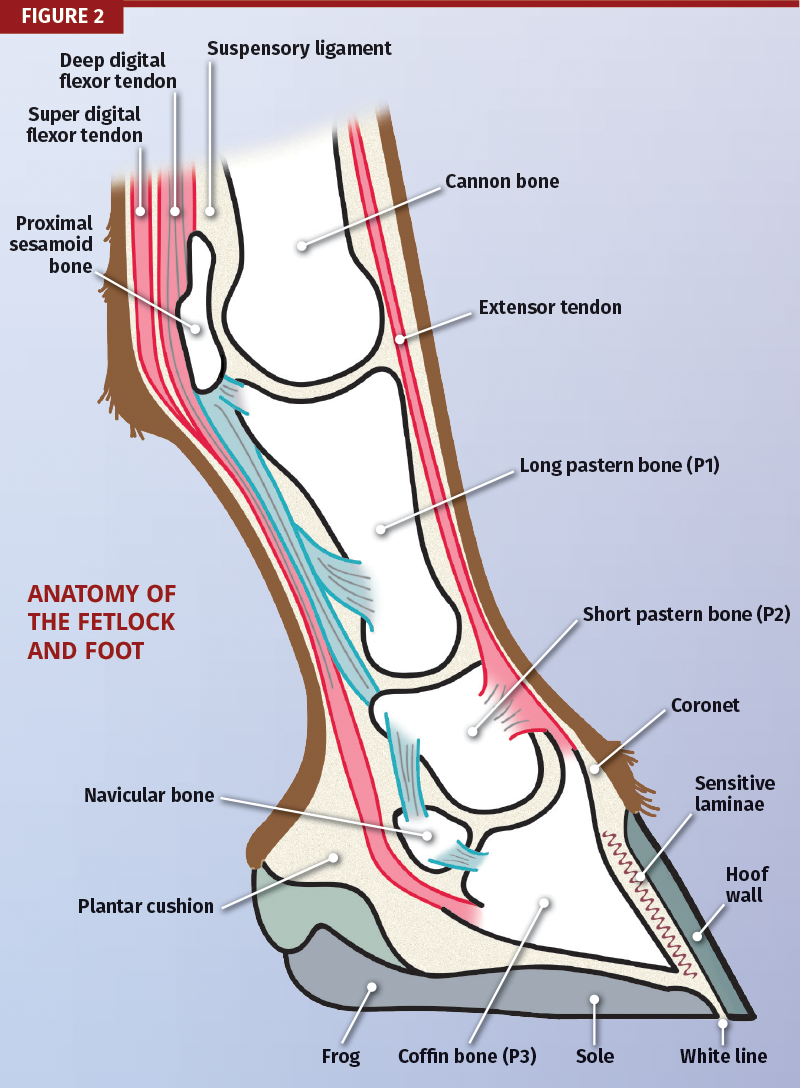
The hoof-pastern alignment is an excellent baseline indication of whether the horse is shod correctly, i.e., broken forward or broken back axis compared to being in line (Figure 3).
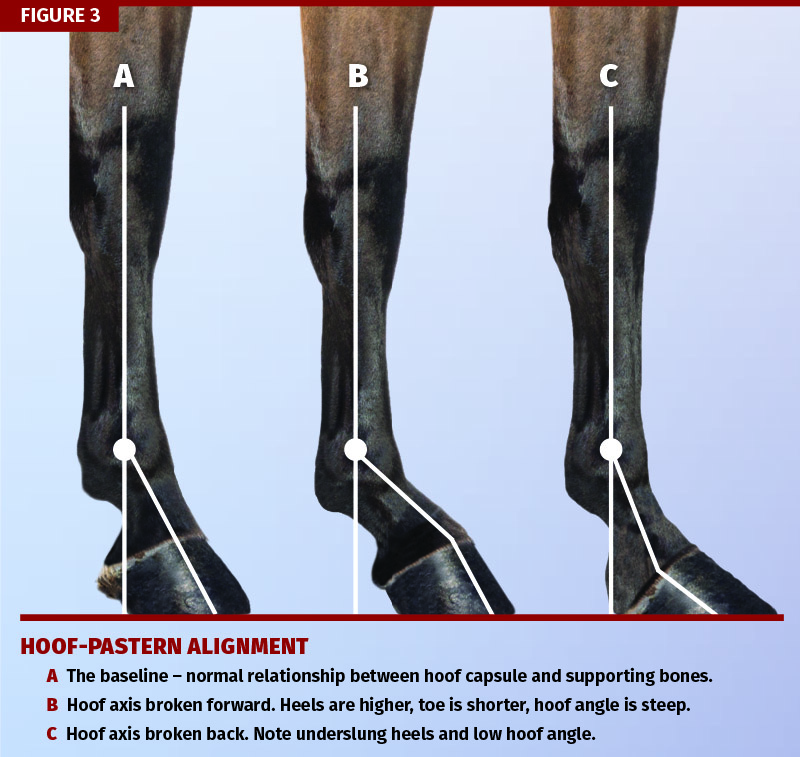
Many farriers choose to cold shoe without clips or appropriate shoe modifications due to lack of knowledge or lack of education. Whether the shoe is handmade from scratch or machine made, it is paramount that the shoe being applied compliments the appropriate trim method and benefits the movement and workload of the horse at the time of shoeing and over the weeks to come.
This method of cold shoeing is not wrong; it’s simply not as accurate because it does not allow the shoe to be custom-fit to the hoof. A shoe that is forged to fit or made from scratch affords a better fit. Fitting and shoe size will otherwise almost always be compromised due to the restrictions of machine-made shoe sizing and what is available right out of the box. Shoes most often fit hooves best in quarter-inch increments, and even though there are many good brands of machine-made shoes, most only come in half-inch increments. Also, horses rarely have a matched pair of feet.
The hoof wall grows downward at an average rate of approximately one-quarter to one-half an inch per month. The minute a shoe is applied, this hoof growth no longer wears down, hence the importance of regular farrier appointments. As the hoof length increases, the appropriate HPA deviates toward a lessor angle, causing stress.
Many farriers have a basic knowledge of anatomy, but greatly lack the forging ability and skill on the anvil that is required to support the horse’s anatomy through application of customized shoes.
A farrier’s ability to manipulate steel is a vastly under-appreciated talent. Most horses are extremely stoic and soft tissue can be very forgiving, for a time. Many horses end up compensating and performing even though the shoeing job is not correct or adequate. Horses will tolerate wearing almost anything on their feet, but this does not mean that this substandard shoeing won’t cause debilitating soundness issues at some point, and in the worst-case scenarios, early retirement or euthanasia.
The most common issues seen with poor farriery are toes left too long, heels and or soles over-trimmed, shoes fit too big or too small, and inappropriate nail placement. If not addressed, these basic issues can cause radical lameness later on.
Length is leverage and leverage causes movement and stress, which can result in distortion, flares, and crushing of the heels. Heels follow the toe, which means with toe growth (length) the heels will also move forward. Long toes can cause a myriad of problems including but not limited to tendon strain, navicular issues, and the breakdown or crushing of the internal and external heel region of the hoof.
Related: The Well-Fed Foot
A common question is: What makes a shoeing job good or bad? A good shoeing job is one that consists of the following (Figure 4):
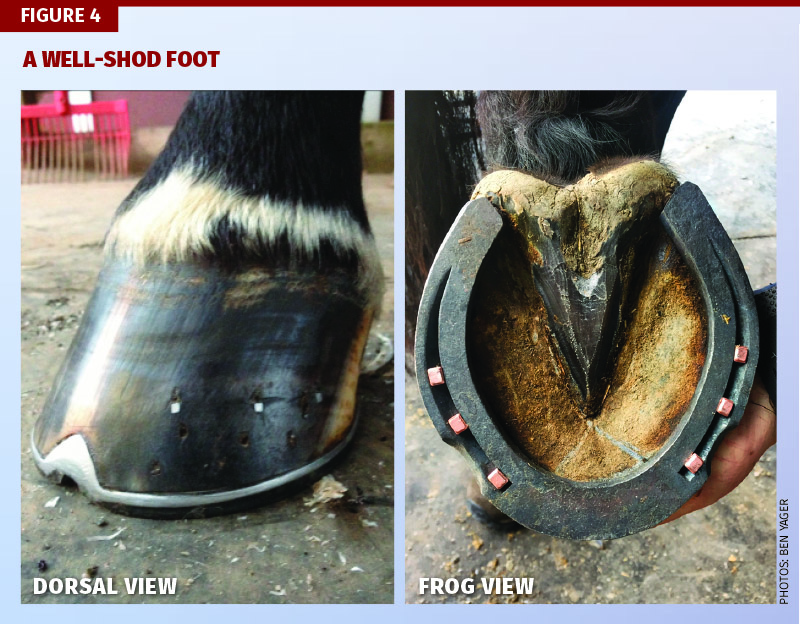
- Appropriate, flat and level trim;
- Correct amount of toe and or heel taken to appropriate anterior/posterior angles;
- Flares dressed to appropriate medial and lateral balance, containing capsular distortion;
- Appropriately chosen machine-made, handmade, or modified shoe;
- Appropriately chosen nail size and placement pertaining to the shoe chosen;
- The shoe must accurately follow the perimeter of the trim and adequately cover the heel, terminating just past the end of the buttress (at about the widest part of the frog, in a healthy foot);
- HPA has been adhered to, barring any gross pathology;
- No sole pressure;
- A nice tidy nail line (approximately one-third of the way up the hoof wall);
- Tight, properly seated clinches, with a smooth finish free of rasp marks.
Many times a good shoeing can be undone by the care provided between farrier visits. This scenario happens more often than one might think. In order to minimize potential lameness or capsular distortion, it is paramount that an appropriate shoeing cycle and proper stabling conditions are adhered to.
There are many scenarios that cause a decent shoeing job to deteriorate. Wet paddocks, damp stabling, feet not being picked out daily, inappropriate nutrition, and lengthy intervals between shoeing appointments are all detrimental to hoof conditions. It is imperative to maintain a hoof care schedule that reflects the growth rate of your horse’s hooves in any given season. Many horse owners sacrifice quality stabling and regular shoeing visits in order to save money. However, in the long run they may end up spending more money due to lameness, visits from the veterinarian, and the need for therapeutic shoes or even euthanasia.
Breeding also plays a role in the quality of horses’ hooves and can often be a contributing factor to lameness. Many times breeding is compromised for the sake of convenience or cost, resulting in offspring with less than desirable limbs or feet. Unsound horses often become broodmares, passing on their conformation flaws and weaknesses to their foals. If conformation issues are not addressed or monitored from the start, they can become greater problems at a later date and may result in another horse becoming unsuitable for riding.
The equestrian sports have changed over the years and much greater demands are being placed on these athletic horses. As a result, those with conformational or limb defects often develop soundness problems if not attended to by a competent farrier who can create custom or corrective shoes. Breakdown or lameness can also occur when a horse that has spent the winter months with little attention to its feet is then shod just before a show. In all seasons the horse should be given adequate hoof care to allow him to better assist you in obtaining your competitive or leisure goals.

It is also important to be well prepared for your first competition or clinic of the year. Ask your farrier for appropriate shoes for the ground you horse will be working on. Not all shoes are created equal and not all working surfaces are meant for one type of shoe. Tell your farrier in advance if the horse may need studs, pads, or specific shoes to accommodate the upcoming show or clinic.
The changing seasons from wet to dry and back to wet again in some areas strongly dictate the length of the shoeing cycle but regions aside, a shorter five-week cycle is much preferred. The argument could be made that this creates up to three extra shoeings a year, but this schedule allows for a tighter, more contained healthy hoof capsule and a nice short toe, which are essential for the horse’s comfort and well-being.
Horse owners who choose a much lengthier schedule and expect to still ride at the horse’s optimum ability may find that injuries such as leg or tendon strain occur at a much higher frequency. On a longer shoeing cycle horses can also see problems such as thrown or loose shoes, which are caused by strained or lengthy hoof capsules. This could result in an expensive repair job to the foot or possibly time off.
Remember: Prevention is cheaper than prescription when it comes to most things, but especially hoof care. The ongoing practice of good animal husbandry coupled with appropriate conditioning, shoeing, and stabling habits will make for a sounder, better performing equine athlete.
Related: Do Horses Have Hidden, Ancient Toes?
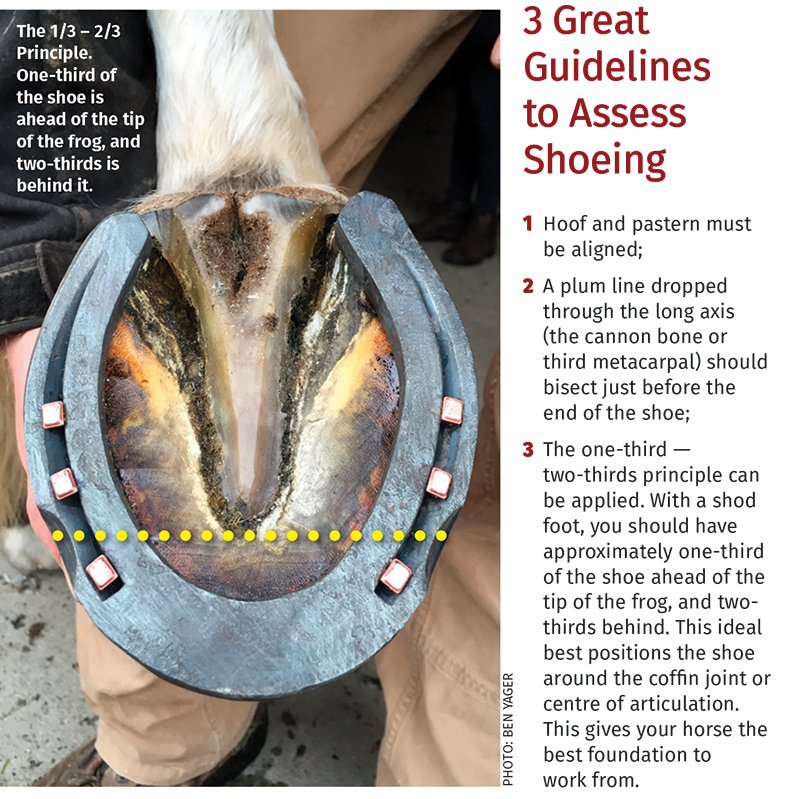
Farrier-Horse Owner Etiquette
Top 12 Tips
1 - Always disclose all pertinent information, such as the horse’s medical conditions, injuries, or history of misbehaving. Never tranquilize a horse prior to a shoeing appointment without letting the farrier know.
2 – Teach your horse to stand for the farrier. The calmer your horse is to shoe, the better the shoeing job.
3 – Pay promptly for services rendered.
4 – Be an active, not a passive, horse owner. Be present so you understand your horse’s shoeing and any changes in the hoof condition or shoeing procedure. Be there to deal with your horse and walk/trot him out so your farrier can assess how he moves.
5 – If you have a show, endurance ride, vacation, etc. coming up when your horse is due to be shod, be proactive and move your shoeing up so you are riding with optimum foot conditions.
6 – Clean your horse’s feet and legs. Don’t handicap your farrier by having a horse that isn’t clean.
7 – If you need to change anything give lots of notice because the farrier books six weeks in advance, i.e., if you need more/less shoes, studs, the horse has moved, has been sold or has died.
8 – Don’t cancel a farrier booking for a lesson or because you want to ride. No foot no horse. Shoeing should always be a priority.
9 – Have a well-lighted sheltered area for the farrier to work in – if he can’t see it, he can’t shoe it.
10 – Respect that the farrier shoes hundreds of horses, and often has to attend emergencies. Try to respect your farrier’s business hours.
11 – Always give the farrier a chance to explain their work. Often loyalty is compromised for the sake of a few dollars or another expert’s opinion. A mutual client-farrier relationship must be established.
12 – Book in advance, so your horse’s feet don’t get too long and problems occur. Trust that your farrier knows how long your horse can go, and that it may change with the season. Prevention is cheaper than prescription.
Related: Do Horseshoes Affect the Foot Skeleton
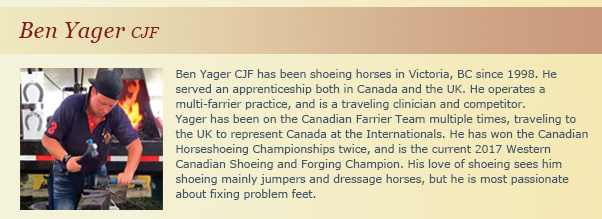
Main image: Shutterstock/VerityJohnson




